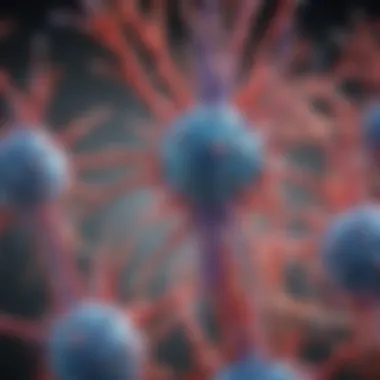Glycan Analysis of Monoclonal Antibodies: A Comprehensive Review


Intro
Glycans are complex carbohydrates that play a vital role in the function and effectiveness of monoclonal antibodies. Their structures can significantly influence drug efficacy and safety. Analyzing these glycans has become crucial in biopharmaceutical research. Researchers are actively engaged in understanding their intricate structures and analyzing the various methodologies that can be applied to study them. This analysis has implications not only for the development of novel therapeutic agents but also for ensuring the safety of existing treatments.
The following sections delve into our findings on glycan structures and their functions in monoclonal antibodies. We also outline the importance of advanced analytical techniques used in glycan characterization.
Research Highlights
Overview of Key Findings
- Glycan structures exhibit heterogeneity, impacting the pharmacokinetics and immunogenicity of monoclonal antibodies.
- Advanced methods, such as mass spectrometry and high-performance liquid chromatography, have enhanced our ability to accurately analyze glycan profiles.
- Through extensive research, novel glycan biomarkers have been identified, which may influence therapeutic outcomes.
Significance of the Research
Glycan analysis holds profound importance in the biopharmaceutical field. Understanding how glycan structures affect the functionality of monoclonal antibodies can lead to better-targeted therapies. The information garnered from detailed glycan analysis may help address issues such as adverse immune reactions and improve overall therapeutic efficacy.
"Glycan structures are not merely decorative; they are critical in enhancing the therapeutic functionalities of monoclonal antibodies."
Original Research Articles
Summary of the Article
This article discusses the latest findings in the field of glycan analysis, providing a thorough exploration of the biochemical properties of glycans and their implications for monoclonal antibodies. Utilizing various analytical techniques, the research highlights the necessity to properly characterize glycans to fully harness their therapeutic potential.
Author Contributions
Several key contributions have emerged from this research. The authors utilized their collective expertise in biochemistry and pharmacology to investigate glycan structures. Their work has laid the groundwork for future research aimed at understanding the multifaceted roles of glycans in drug development.
Prolusion to Monoclonal Antibodies
Monoclonal antibodies hold a pivotal role in modern biopharmaceuticals. These engineered proteins are designed to target specific antigens, making them indispensable in diagnostics and therapeutics. The rise of monoclonal antibodies has not only transformed treatment protocols across various diseases like cancer and autoimmune disorders, but they have also significantly improved patient outcomes.
In this article, we delve into the complexities of glycans associated with monoclonal antibodies. Understanding glycan structures and their analysis bears substantial relevance, as glycosylation can notably influence the functionality and effectiveness of these therapeutics. Glycans play crucial roles in monoclonal antibodies, including their stability, half-life, and even their potential to elicit immune responses.
Definition and Overview
Monoclonal antibodies are antibodies that are identical because they are produced by one type of immune cell. This specific targeting capability makes them valuable for therapeutic applications. They are generated through hybridoma technology, where a single B-cell is fused with a myeloma cell, allowing for the creation of a cell line that can produce unlimited quantities of a particular antibody.
These antibodies can be humanized or fully human, which reduces the risk of immunogenicity when administered to patients. Such precision in antibody production allows biopharmaceutical companies to tailor treatments that are highly effective and target specific disease markers.
Therapeutic Applications
The therapeutic applications of monoclonal antibodies are vastly expanding in today’s medical fields. Here are some critical areas where they are utilized:
- Cancer Treatment: Monoclonal antibodies are employed to target cancer cells specifically, marking them for destruction by the immune system. Examples include trastuzumab, used for HER2-positive breast cancer.
- Autoimmune Diseases: They help inhibit immune responses that cause tissue damage, such as in rheumatoid arthritis, where rituximab is often used.
- Infectious Diseases: They can neutralize viruses or bacteria, playing a role in preventing or treating infections.
- Diagnostic Tools: Monoclonal antibodies are integral in test kits and assays, providing accurate detection of diseases.
Despite their benefits, challenges remain. Cost of development and the need for rigorous testing for safety and efficacy can complicate their use. Even so, the continual advancements in monoclonal antibody technology, particularly in glycan analysis, hold promise for enhancing their therapeutic potential.
Understanding Glycans
Glycans are essential components in the molecular landscape of biological systems. In the context of monoclonal antibodies, understanding glycans becomes crucial. Glycans influence how these antibodies behave within the body, their stability, and their overall effectiveness in targeting diseases. The intricate structures and variations in glycan composition can affect immunogenic responses, therapeutic efficacy, and clearance rates from the body. Therefore, a deep dive into glycans provides insights that are vital for improving the design and functional outcomes of monoclonal antibodies.
Basic Structure of Glycans
Glycans are carbohydrates consisting of sugar molecules linked together in various structures. They can form complex branching patterns that significantly impact their biological functions. The basic structure typically includes simple sugar units called monosaccharides that can bond together through glycosidic linkages. This structural diversity is largely responsible for the different functions and roles that glycans play in biological processes. Recognizing these basic elements allows researchers to appreciate how glycan profiles can alter the properties of monoclonal antibodies.
Types of Glycans
Glycans are categorized into three main types: monosaccharides, oligosaccharides, and polysaccharides. Each type holds unique significance in the context of monoclonal antibodies.
Monosaccharides


Monosaccharides represent the simplest form of glycans. These single sugar units have profound implications since they serve as the building blocks for more complex carbohydrates. A notable aspect of monosaccharides is their diverse functional groups, which affect reactivity and solubility. In monoclonal antibodies, monosaccharides can impact binding affinity and specificity, making them essential for therapeutic effectiveness. They are also easily metabolized, providing benefits for modifications that can enhance antibody properties. However, their straightforward structure limits the complexity needed to observe significant biological activity.
Oligosaccharides
Oligosaccharides are formed from the union of two to ten monosaccharides. They can have varied structures, including linear and branched forms. This diversity allows them to play versatile roles in glycoproteins, specifically monoclonal antibodies. A key characteristic of oligosaccharides in this context is their ability to mediate important biological interactions, such as with cell surface receptors. They can enhance the stability and solubility of antibodies, making them a popular choice in therapeutic applications. However, the complexity of their structures presents challenges in analysis and characterization, often requiring advanced techniques.
Polysaccharides
Polysaccharides are long chains of monosaccharides linked together, often comprising hundreds of units. They provide significant structural diversity and complexity. One of the most beneficial aspects of polysaccharides is their ability to form gels and modify viscosity, which can be crucial in drug formulation. Within monoclonal antibodies, polysaccharides contribute to the overall stability of the therapeutic agents and can influence their half-life. However, their extensive sizes can make them difficult to analyze, necessitating specialized methods for effective glycan profiling.
Biological Functions of Glycans
The biological roles of glycans in the context of monoclonal antibodies are multifaceted. They are involved in cell recognition, signaling pathways, and immune system responses. Glycans can affect the biological activity and pharmacokinetics of monoclonal antibodies, influencing their distribution, metabolism, and excretion. Ultimately, understanding these functions is critical for optimizing therapeutic strategies and ensuring enhanced safety and efficacy in applications.
The nuances of glycan structures can determine the fate of both the monoclonal antibodies and the patients they aim to treat.
Importance of Glycosylation in Monoclonal Antibodies
Glycosylation plays a critical role in the functionality and efficacy of monoclonal antibodies. This post-translational modification can greatly influence various properties of antibodies, from their stability to their interaction with the immune system. Understanding the significance of glycosylation helps researchers and biopharmaceutical developers enhance the therapeutic potential of monoclonal antibodies, leading to improved patient outcomes.
Impact on Pharmacokinetics
Pharmacokinetics describes how a drug moves through the body, which includes absorption, distribution, metabolism, and excretion. Glycosylation affects these processes significantly. Antibodies with different glycan structures can have altered serum half-lives. For instance, increasing the sialylation of an antibody can enhance its anti-inflammatory properties, prolonging its half-life in circulation. This means the drug remains effective longer and requires less frequent dosing. Conversely, certain glycan patterns can lead to quicker clearance from the bloodstream, negatively impacting their therapeutic efficacy.
Influence on Therapeutic Efficacy
The effectiveness of monoclonal antibodies as therapeutic agents is closely linked to their glycan structures. Glycosylation not only affects the binding affinity to antigens but also impacts the antibody's ability to recruit immune cells. For example, antibodies with specific fucose residues can demonstrate stronger antibody-dependent cellular cytotoxicity (ADCC) compared to their non-fucosylated counterparts. This suggests that careful engineering of glycosylation sites could lead to more effective treatments for diseases such as cancer.
Role in Immunogenicity
Immunogenicity refers to the ability of a substance to provoke an immune response. Glycans can play a pivotal part in this process. Non-human glycan structures present on monoclonal antibodies can trigger unwanted immune responses in patients, which may lead to reduced efficacy or adverse effects. For instance, the presence of certain high-mannose glycans can enhance immunogenicity, further challenging the safety profile of the antibody. Understanding glycosylation patterns allows researchers to engineer antibodies with lower immunogenic potential, thus improving patient safety and acceptability.
This underscores the necessity for glycan analysis during the development of monoclonal antibodies, ensuring both efficacy and safety of therapeutics.
Techniques for Glycan Analysis
Glycan analysis is vital in understanding the complexity of monoclonal antibodies. The techniques employed in this area of study not only help in the precise characterization of glycans but also influence the overall therapeutic efficacy and safety of monoclonal antibodies. Considering the diverse glycan structures, their varied biological functions necessitate sophisticated analytical techniques to unravel the full extent of their roles in therapeutic frameworks.
Mass Spectrometry
Mass spectrometry stands out as a leading technique for glycan analysis. It enables researchers to determine the mass-to-charge ratio of glycan molecules, providing critical insights into structure and composition. Through ionization of glycans, mass spectrometry can identify both the molecular weight and structural information, facilitating the investigation of glycan heterogeneity.
The advantages of mass spectrometry include:
- Sensitivity: Capable of detecting low abundance glycans.
- Speed: Faster results compare to traditional methods.
- Detailed Structural Information: Allows for fragmentation analysis to determine structural details.
However, it requires careful sample preparation and can be influenced by factors such as ionization efficiency and instrument calibration. Researchers must pay attention to these variables for reliable outcomes.
High-Performance Liquid Chromatography
High-Performance Liquid Chromatography (HPLC) is another widely utilized method in glycan analysis. This technique separates glycans based on size, charge, or hydrophobicity, allowing for comprehensive profiling. It demands the use of specialized columns that are chosen based on the properties of the target glycans.
Key benefits of using HPLC include:
- High Resolution: Separates complex mixtures effectively.
- Quantitative Analysis: Facilitates accurate quantification of glycan components.
- Compatibility: Can be coupled with other methods such as mass spectrometry for enhanced analysis.
A downside is the need for extensive optimization of parameters like flow rate and temperature to attain reproducible results.
Capillary Electrophoresis
Capillary Electrophoresis (CE) is an emerging technique in glycan analysis, characterized by the separation of glycans in a capillary tube under an electric field. This method is particularly effective for analyzing small amounts of sample, making it a suitable option when sample availability is limited.


The primary advantages of CE include:
- Speed: Often quicker than other methods due to reduced analysis time.
- Minimal Sample Needs: Requires less sample volume, appealing for precious or rare samples.
- High Resolution: Similar to HPLC, it provides excellent separation quality.
Nevertheless, CE often struggles with complex mixtures, where overlapping peaks can complicate interpretation of results.
Glycan Microarrays
Glycan microarrays represent an innovative approach for glycan analysis. These arrays enable the simultaneous analysis of numerous glycans, providing broad accessibility and comprehensive screening capabilities. They are particularly useful for studying glycan-protein interactions, which are crucial for understanding biological processes.
The notable aspects of glycan microarrays are:
- High Throughput: Allows simultaneous analysis of multiple samples.
- Diverse Applicability: Useful for various applications, including diagnostics and drug development.
- Detailed Interaction Analysis: Facilitates the probing of glycan binding properties.
However, designing effective microarrays can be challenging and requires a deep understanding of glycan structures.
"Understanding these techniques is key for analyzing glycans in monoclonal antibodies and is critical for advancing therapeutic applications."
In summary, various techniques such as mass spectrometry, HPLC, capillary electrophoresis, and glycan microarrays each provide unique advantages for glycan analysis. Selecting the appropriate method often depends on specific research questions, sample types, and desired outcomes. The interplay of these techniques elaborates a clearer understanding of glycans within monoclonal antibodies, grounding the foundation for enhancing their therapeutic potential.
Interpreting Glycan Profiles
Interpreting glycan profiles is essential in understanding the complexities of monoclonal antibody development. The specific glycan structures attached to these antibodies can significantly influence their biological functions. A thorough analysis allows researchers to determine how variations in glycosylation affect not just the stability and activity of the antibodies, but also their therapeutic outcomes. In this section, we will explore the methodologies employed in interpreting these profiles and the implications that arise from such analyses.
Data Analysis Techniques
Data analysis techniques play a crucial role in interpreting glycan profiles. Various methods are available for quantifying and identifying glycans, each with its unique benefits and limitations. High throughput analysis is often necessary, given the complex nature of glycosylation. Common strategies include:
- Mass Spectrometry: This technique is favored for its sensitivity and ability to provide detailed information on glycan composition and structure. It allows for the identification of different glycan species present in a sample.
- High-Performance Liquid Chromatography (HPLC): Often utilized for the separation of glycan mixtures, HPLC can effectively quantify individual glycan structures, making it a valuable tool in profiling.
- Capillary Electrophoresis: This method is useful for separating glycans based on their charge and size. It provides rapid analysis, which can be a significant advantage in large-scale studies.
These techniques generate extensive data sets that require careful interpretation. Advanced bioinformatics tools are now increasingly applied to analyze the data generated by these methodologies. Machine learning models can identify patterns in glycosylation that correlate with therapeutic efficacy and safety. Researchers must remain vigilant about the variability introduced by sample handling and analysis conditions, as these factors can mask true biological insights.
Clinical Implications of Glycan Variation
The clinical implications of glycan variation cannot be overstated. Changes in glycosylation can lead to differences in pharmacokinetics, immunogenicity, and overall therapeutic effectiveness. Understanding these variations is critical for:
- Optimizing Drug Formulations: By analyzing glycan profiles, pharmaceutical scientists can tune antibody molecules for improved stability and performance in clinical settings.
- Enhancing Patient Safety: Identifying glycan structures that may increase immunogenic responses can lead to safer therapeutic designs, reducing the risk of adverse effects in patients.
- Personalized Medicine: As more is understood about the relationships between glycan structures and patient responses, tailored therapies could be developed, ensuring better outcomes for individuals based on specific glycan modifications.
Understanding glycan profiles is not just about scientific curiosity; it is about enhancing the quality and safety of monoclonal antibody therapies, leading to better patient outcomes.
Regulatory Perspectives on Glycan Analysis
Understanding regulatory perspectives on glycan analysis is essential in the biopharmaceutical field, particularly regarding monoclonal antibodies. This section evaluates how regulatory authorities shape the standards and practices for analyzing glycans in these therapeutic proteins. Glycan structures play a vital role in the safety and efficacy of monoclonal antibodies. Hence, adherence to regulatory guidelines ensures not only compliance but also the overall quality of biologic products.
The regulation of glycan analysis incorporates several important elements. These guidelines streamline research and development processes, helping scientists to align their work with industry standards. This alignment is particularly beneficial in the context of market approval, where demonstrating strict regulatory compliance is often a requirement that can significantly influence product success. As glycosylation impacts pharmacokinetics, the influence on therapeutic efficacy, and immunogenicity, understanding these guidelines provides valuable insights into what constitutes a high-quality monoclonal antibody therapy.
Additionally, a robust regulatory framework facilitates best practices in glycan analysis. This might include specifying analytical methodologies, validation protocols, and control measures. Such structure decreases the likelihood of variability in findings, and ensures interoperability between studies and reproducibility over time. In short, the regulatory perspectives on glycan analysis serve as a crucial foundation for advancing biopharmaceutical science effectively and responsibly.
Guidelines from Regulatory Authorities
Regulatory authorities, such as the FDA and EMA, have set forth specific guidelines for glycan analysis that are integral to the lifecycle management of monoclonal antibodies.
- International Conference on Harmonisation (ICH): The ICH provides a framework that promotes harmonization of regulations across different regions, which is essential for global product approval.
- Guidelines for the Development of Therapeutic Monoclonal Antibodies: These include principles for glycosylation assessment, detailing acceptable ranges for variation in glycan structures.
- Bioanalytical Method Validation: This guide stipulates the requirements for validating analytical methods employed in glycan analysis, ensuring reliability and accuracy in results.
By understanding these guidelines, researchers can navigate the path toward regulatory approval more effectively. Continuous alignment with these standards can also facilitate smoother reviews and enhance the communication between regulatory bodies and biopharmaceutical developers.
Quality Control in Biologics
Quality control in biologics, particularly monoclonal antibodies, hinges significantly on glycan analysis. Ensuring that the glycosylation pattern is consistent is critical to maintaining the therapeutic efficacy and safety of the product. Good manufacturing practices (GMP) necessitate comprehensive quality control measures that involve regular glycan profiling.
- Monitoring Glycan Structures: Consistent monitoring during production helps to identify non-conformities early in the process.
- Batch-to-Batch Consistency: Quality control protocols aimed at ensuring batch consistency prevent variations that may affect drug performance.
- Limit Setting for Glycan Variability: Establishing acceptable limits for glycan variability is essential to meet regulatory benchmarks and ensure patient safety.


Quality control procedures serve not only to meet regulatory requirements but also to bolster confidence among stakeholders in the biopharmaceutical industry. By sustaining high-quality standards, companies can assure that their monoclonal antibodies will perform effectively and reliably in clinical settings, ultimately benefiting patients.
Challenges in Glycan Analysis
The analysis of glycans in monoclonal antibodies presents distinct challenges that can complicate research and application in biopharmaceutical development. Understanding these challenges is crucial for researchers, as it influences the design of analytical methods and the interpretation of data. The complexity of glycan structures leads to various technical limitations and the inherent variability that can occur in glycosylation patterns.
Technical Limitations
One of the most formidable challenges in glycan analysis is the technical limitations of the current methodologies. Techniques like mass spectrometry, while powerful, require precise sample preparation and calibration. The sensitivity of mass spectrometers to contaminants and matrix effects can compromise the data integrity.
High-Performance Liquid Chromatography (HPLC) also has its drawbacks; it can struggle to resolve closely related glycan structures. This lack of resolution limits the precision of identifying specific glycan variants. Another technique, Capillary Electrophoresis, may not provide comprehensive information about the glycan’s structure or its distribution.
"Addressing the technical limitations is essential for accurate glycan profiling, which directly affects the quality of monoclonal antibody therapeutics."
Thus, advancements in glycan analysis methods are vital. New technologies and improvements to existing methods will enhance the ability to characterize complex glycans effectively.
Variability in Glycosylation Patterns
Glycosylation patterns across different monoclonal antibodies exhibit significant variability. This variability arises from several factors, including cell line differences, production conditions, and even the passage number of the cell lines used for antibody production. The immunoglobulin molecules can demonstrate a wide range of glycan structures, influencing their function and stability.
The impact of this variability can be profound. For instance, differences in glycosylation can affect the pharmacokinetics, immunogenicity, and efficacy of therapeutic antibodies. Monitoring these variations is vital for ensuring consistent quality across batches of monoclonal antibodies.
Future Directions in Glycan Analysis
The field of glycan analysis in monoclonal antibodies is rapidly evolving. As scientific understanding deepens, new methods and technologies emerge, enhancing our capability to analyze glycans. This section focuses on the promising future directions within this domain, essential for ensuring that monoclonal antibodies remain safe and effective in therapeutic settings. Exploring these future advancements can lead to significant improvements in drug development processes.
Innovative Analytical Techniques
Innovative analytical techniques are pivotal for the future of glycan analysis. Current methodologies like mass spectrometry and high-performance liquid chromatography have made strides, but emerging technologies promise even greater precision and efficiency. Techniques such as next-generation sequencing and advanced chromatographic methods may enable a more detailed understanding of glycan structures down to the molecular level. This advancement can lead to better quality control and a greater assurance of therapeutic consistency.
Some of the innovative techniques include:
- Microfluidics: This technology allows the manipulation of small volumes, enabling rapid analysis of glycan samples.
- Nanotechnology: Utilizing nanoparticles can enhance the sensitivity of glycan detection methods, offering more accurate profiling.
- Machine Learning: Integrating AI allows for improved data interpretation and pattern recognition within complex glycan profiles.
The adoption of these new technologies not only enhances analytical capabilities but also accelerates the pace of research and development in the biopharmaceutical field.
Integration with Genomic Data
The integration of glycan analysis with genomic data is another frontier that holds immense potential. This approach can lead to a more comprehensive understanding of how glycosylation is affected by genetic factors. By studying the relationship between genomic variations and glycan structures, researchers can better predict glycan profiles associated with specific monoclonal antibodies.
The benefits of this integration include:
- Personalized Medicine: Tailoring treatments based on individual genetic makeup can improve therapeutic efficacy.
- Enhanced Safety Profiles: Understanding genetic influences on glycosylation may minimize adverse reactions.
- Valorization of Biotherapeutics: With insights derived from genomic data, developers can create more effective monoclonal antibodies with optimized glycan structures.
"The future of biopharmaceuticals lies in the ability to link genetic information with glycan characterization, paving the way for personalized treatments and improved patient outcomes."
Integrating this data also necessitates interdisciplinary collaboration. Combining the expertise from genomics, bioinformatics, and glycomics will yield richer insights and propel the field of monoclonal antibody development forward.
Ultimately, it is clear that advancements in innovative analytical techniques and the integration of genomic data will shape the future landscape of glycan analysis, reinforcing its pivotal role in monoclonal antibody therapeutics.
Culmination
In this article, the examination of glycan analysis in monoclonal antibodies emphasized its crucial role in biopharmaceutical development. Glycosylation directly affects the pharmacokinetics, therapeutic efficacy, and immunogenicity of monoclonal antibodies. A clear understanding of glycan structures and functions is necessary for optimizing these therapeutic agents.
Summary of Key Insights
The relationship between glycan structures and their functions is complex yet essential. Key insights include:
- Impact on Therapeutic Outcomes: Variations in glycan composition can significantly influence drug effectiveness and patient responses.
- Analytical Techniques: The development of robust analytical methods like mass spectrometry and high-performance liquid chromatography has advanced the field.
- Regulatory Considerations: Regulatory frameworks are adapting to include guidelines addressing glycan analysis to ensure safe and effective therapeutics.
Thus, a comprehensive grasp of glycan profiles can aid in developing efficient monoclonal antibodies that maximize patient benefits.
Significance of Ongoing Research
Ongoing research into glycan analysis is paramount for several reasons:
- Innovation in Therapeutics: Continuous exploration of new glycan structures can lead to the development of more effective and safer monoclonal antibodies.
- Personalized Medicine: Understanding individual glycosylation patterns can enhance tailored treatments, improving patient outcomes.
- Public Health Implications: The implications of glycan analysis are profound for global health, impacting the management of diseases and the development of vaccines.
As such, prioritizing research in glycan analysis will ensure the advancement of biopharmaceuticals, addressing existing challenges and paving the way for future innovations.







